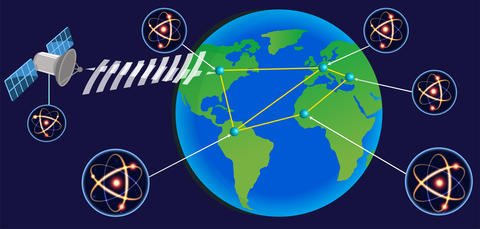Quantum Networks at NIST

Quantum technologies employ quantum mechanical effects such as superposition, interference, and entanglement to gain an advantage over conventional technology. While limited forms of quantum effects are present and essential in many modern technologies, it has become evident that there are tasks that can be performed significantly better if quantum effects are exploited directly.
For example, quantum-enabled measurements can reach better accuracy in less time, and quantum computers can solve certain computational problems much faster. Most of these applications require long-lived superpositions and entanglement. At present, relatively short-lived superpositions and entanglement are achievable and used in demonstrations of devices known as intermediate-scale quantum processors and limited quantum-enabled measurement tasks. Research is ongoing to exploit the full range of promised quantum advantages.
Multiple applications require communications between quantum nodes and computers. The number of such applications is on the rise. Communication systems that support quantum communications - quantum networks - are key to many quantum technologies. To support the development of this infrastructure, NIST is conducting fundamental research and developing core technologies. This effort includes characterization of quantum communications technologies and validation of their performance. This work requires multidiscipline research and includes scientists and engineers from across NIST including ITL, CTL, MML, and PML laboratories. Throughout these pages, you will be able to get insight into what NIST is doing in quantum networking, and how you can benefit or get involved.
Quantum communications is the exchange of information carriers that can support superpositions and entanglement and cannot be operationally accomplished with classical information exchange. The communication carriers of a quantum network are qubits. Qubits can be prepared in superpositions of the values 0 and 1, and multiple quantum bits can be entangled.
Special technologies are needed for exchanging qubits. For example, unknown arbitrary qubits cannot be perfectly duplicated and therefore quantum information cannot be amplified when traveling over long distances. Thus, those technologies primarily aim at minimizing and mitigating communication loss. These key required technologies are:
- Sources of nonclassical light
- Single-photon detectors
- Quantum memory and repeaters
- Transducers
- Auxiliary quantum and control protocols (error correction, communication protocols, synchronization)
Currently, three major applications of quantum communications are envisioned and more are expected to emerge. First, the ability to exchange quantum information offers new methods for trusted communication between distant parties on a network while monitoring a communication channel for eavesdropping (quantum cryptography). Second, distributed quantum sensors will measure data simultaneously in different physical locations using shared quantum resources, potentially outperforming current sensing technologies. Finally, connecting quantum computers into clusters can exponentially improve the combined computing power. Research of applications for quantum networks is ongoing.
Contacts
-
(301) 975-5887
-
(301) 975-4281
-
(301) 975-8473

